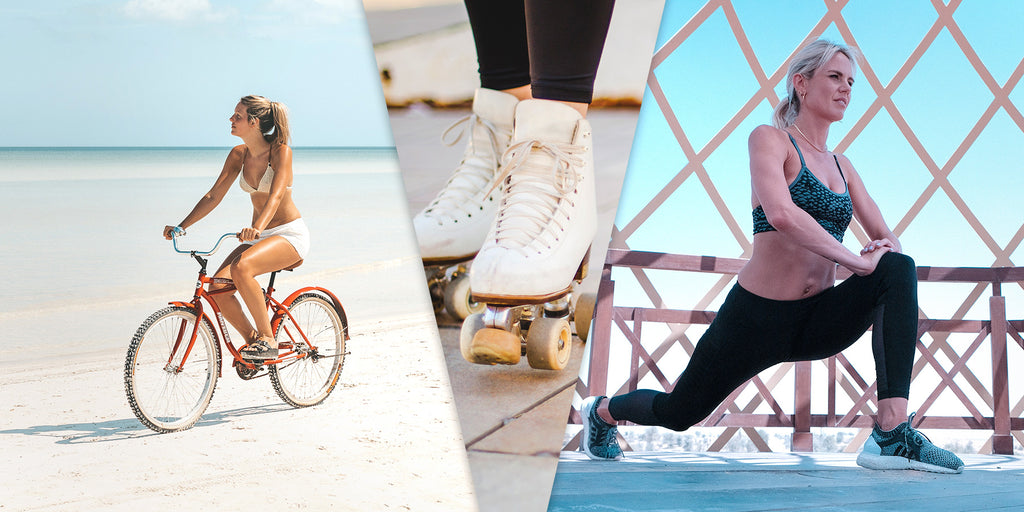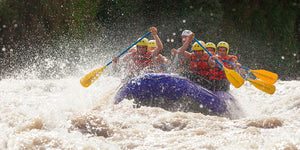5 Exercises to Get Better at Roller Skating

Although roller skating is a workout in itself, focusing on working certain muscle groups in isolation can be a huge benefit to your skating skills. Concentrating on targeted areas instead of relying on roller skating as a whole can help to improve your balance, endurance and overall performance. Most newbie skaters focus primarily on building muscle in their legs. There’s nothing wrong with this — the muscles in your legs are clearly important for skating. But underestimating the importance of other muscles can actually hinder your performance. For a great full-body workout that will improve your skills at the rink, here’s five exercises to add to your routine.
Lunge Stretches
Okay, we know we said that skaters already focus much of their energy on their lower body, but you can’t miss out on the benefits of this stretch. While building muscle is absolutely important, your flexibility can be just as vital to skating.
- Kneel in a deep lunge, with your front knee at a 90-degree angle and your back knee on the floor.
- Lift both of your arms straight up into the air, keeping your arms close to your ears.
- Lift your back knee off the ground and straighten your leg. You should feel a comfortable stretch in your hips.
Bicycles
A roller skating workout on your back? That’s right. Building your core is an absolute necessity for balancing on skates, especially for faster-paced roller sports like derby or rhythm skating. This core-strengthening workout will help you improve your balance and endurance.
- Lay on a flat surface on your back and place your hands behind your head like you’re going to do a sit-up.
- Lift both legs into the air, with your right leg straightened at a 45-degree angle to the floor and your left knee bent, touching your right elbow.
- In a controlled manner, rotate your core and alternate the position of your legs and elbows, so that your right knee now touches your left elbow.
- Repeat this movement.
Planks
This full-body workout is so simple and its extreme versatility makes it easily adaptable to your fit your skill level. We’ll be explaining a basic plank here, but be sure to check out this video with different plank variations to switch it up as your body gets stronger and needs a bigger challenge.
- Get on your hands and feet in a push-up position with your feet shoulder-width apart.
- Make sure that your body is aligned, and your hips don’t sag or push up into the air (it may help to do this exercise in front of a mirror to monitor your own form).
- Hold this position for as long as you can while maintaining proper form.
Glute Bridges
Although roller skating puts a lot of strain on your gluteal muscles, we rarely see roller skaters targeting this muscle group in their at-home workouts. Perhaps this is because they assume that skating is enough of a workout on its own. But your glutes need a little extra attention — they give you a more powerful push and better endurance in your skating stride, so adding this to your workout is a must!
- Lie on your back with your arms at your sides and your knees bent, with your heels sitting close to your butt.
- Straighten one leg so that your foot is straight up in the air at a 90-degree angle to the floor.
- In a controlled manner, lift your hips up so that your body forms a straight line from your shoulders to your knee.
- Switch legs and repeat this same motion.
Jump Squats
You didn’t think you’d get off scot-free without doing squats, did you? Although squats are a great workout for your quads and glutes, they also work the often-ignored muscles in your feet and calves. Adding the extra push of jumping really helps to challenge those muscles and gives you more stability on skates.
- Stand with your feet shoulder-width apart and arms stretched out in front of you like you’re reaching for something.
- Deeply sit into a squat, pushing your butt out behind you without letting your knees stick out past your toes.
- As you come up, swing your arms down toward your body for momentum and jump as high as you can.
- Land your jump with soft knees, immediately sitting back into a squat position.
- Repeat this movement continually while maintaining safe form.
Roller skating is a full-body — not just lower-body — activity. Giving all of your individual muscle groups some attention can really help to improve your performance on skates. By integrating these simple exercises into your routine and improving your full-body strength, you can increase your speed, stability and endurance in roller skates.
Credit: Photo by Rutger Geleijnse on Unsplash and Pexels
- Outdoors Staff






Comments 1
Anonymous
My Favorite is the Glute Bridges… So much Glute.. So little time.